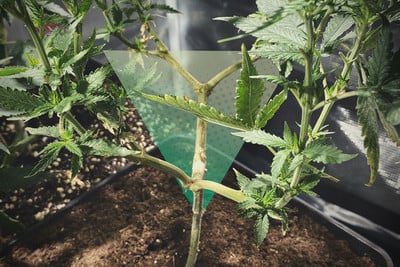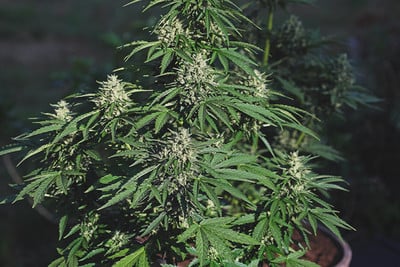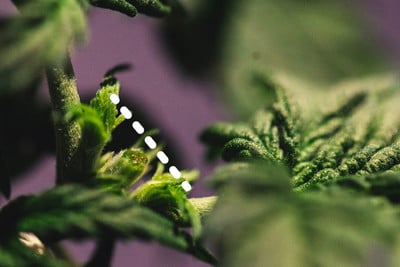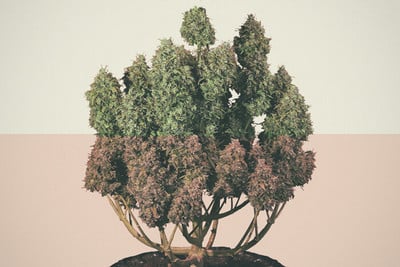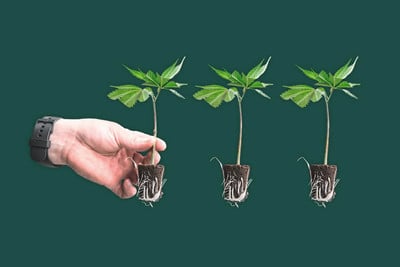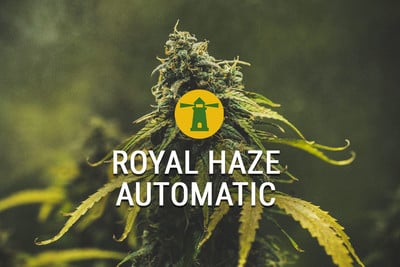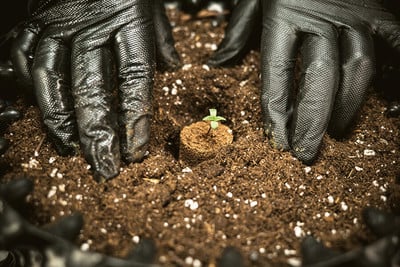.

Topping and Training Autoflowering Cannabis: Can It Be Done?
To top or not to top, that's the question countless auto growers struggle with grow after grow. While it is possible to top and train autoflowering cannabis plants, doing so isn't for the faint of heart.
A guide to training and topping autoflowering cannabis.
Contents:
- What’s the point of topping and training cannabis?
- Should you top and train autoflowering cannabis strains?
- When should you avoid topping/training autos?
- When to try training or topping autos?
- Different training techniques for autoflowering cannabis
- How to top autoflowering cannabis plants
- How to train autoflowering cannabis plants
- Topping and training autos: practice makes perfect
From topping and super cropping to LST and ScrOG, there’s no shortage of training techniques to help you improve the size and quality of your buds. Unfortunately, while you may have plenty of experience using these techniques on regular photoperiod strains, applying them to autoflowering cannabis varieties is a whole different ball game.
In this article, we’ll take an in-depth look at training techniques like topping, fimming, LST, and SOG/ScrOG, and explore how autoflowering strains might respond to the stress caused by these methods and others.
What’s the Point of Topping and Training Cannabis?
Topping and training cannabis plants is all about improving your yields and having more control over how your plants grow. Left to grow as they please, cannabis plants end up looking a lot like Christmas trees, with a wider bottom and a slim central cola. And while they might look great, especially around the festive season, letting your plants grow like this is far from optimal, particularly indoors under a finite source of light.
Training allows you to manipulate the way your plants grow and build an even canopy that makes better use of the light emitted from your lamp. If you simply left your plants to grow as nature intended, their main colas would soak up most of the light in your grow room, leaving you with small, airy flowers down on each plant’s lower bud sites.
Topping, on the other hand, allows your plants to develop multiple colas (clusters of flowers that grow along the main stem and branches), and can greatly improve the number of buds harvested from each plant.
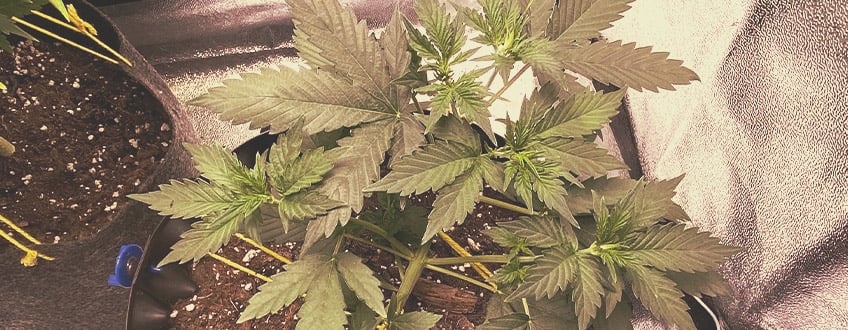
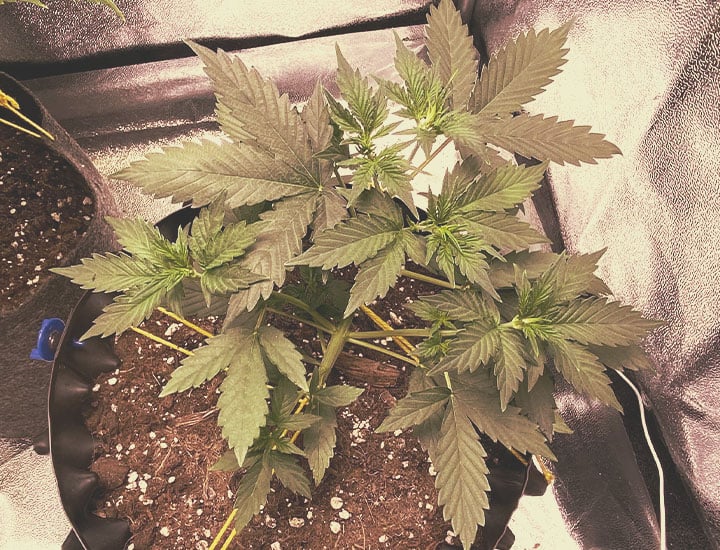
Should You Top and Train Autoflowering Cannabis Strains?
Whether to train and top autoflowering cannabis strains is a highly debated topic among cannabis growers; some swear by it, while others argue it’s a recipe for a disaster. To better understand why, you need to have a basic understanding of the genetic traits of autoflowering cannabis strains.
Unlike photoperiod strains, autoflowers feature genetics from Cannabis ruderalis, a unique variety of cannabis that flowers automatically once mature (unlike indica and sativa varieties, which flower in response to light cycle changes). And, while the autoflowering gene of Cannabis ruderalis obviously has a variety of advantages, it also has some drawbacks.
Topping and training cause your plants some degree of stress, ranging from a minimal amount to a much more significant amount. When growing photoperiod strains, you’re able to compensate for this stress by prolonging a plant’s veg cycle, giving it time to fully recover before flipping it over to bloom. With autoflowering strains, you don’t have the luxury of extending a plant’s veg phase, and this is exactly why some growers stay away from techniques like training, topping, defoliation, or pruning. Some auto strains simply might not be able to recover fully from the stress of these techniques, and may therefore produce lighter, lower-quality harvests.
Pros of Topping and Training Autoflowers
- Potential for multiple colas and larger yields
- More controlled growth
- Wider, flatter canopy (great for growers working in small spaces)
Cons of Topping and Training Autoflowers
- Poor training or late topping can stress plants and reduce the quality and size of their yields
- Inexperienced growers are likely to make mistakes when training or topping
When Should You Avoid Topping/Training Autos?
We generally only suggest training or topping autos if you’ve got a fair bit of growing experience. If this is your first time growing weed (or autos, for that matter), focus on watering and feeding your plants properly and getting to know the strains you’re working with.


When to Try Training or Topping Autos?
Once you’ve got at least 1–2 auto harvests under your belt, feel free to branch out and experiment with topping and training. Just remember to only try these techniques on young, healthy autos. Plants that have been over/underwatered, are suffering from nutrient problems or pest infestations, or simply aren’t growing as vigorously as others won’t have the strength to properly recover from the stress of training/topping.
When training/topping autos, it’s also super important to start early. To avoid stressing your plants as they flower, we recommend you start training or topping them as soon as they’ve developed 3–4 nodes. Most autos start flowering in as little as 3–4 weeks after germinating, and stressing your plants close to this time may stunt their growth or ability to bloom, resulting in disappointing yields.
Finally, when experimenting with training techniques on autos, it’s always best to start with lower-stress techniques first. LST, ScrOG, SOG, and other techniques that involve bending your plants’ stems (rather than cutting or breaking them) are a lot easier on them than topping or fimming (both of which are high-stress techniques).
Different Training Techniques for Autoflowering Cannabis
We’ve discussed topping and training autos in broad strokes, but now it’s time to dig a little deeper. Let’s get into the details on specific training methods to see which ones are most (and least) viable.
LST (Low-Stress Training)
LST is, as the name suggests, a training technique that inflicts a low degree of stress on your plants. It involves gently bending the main stem of your plant and tying it down using wire, string, or pipe cleaners. Over time, this technique teaches your plants to grow outwards rather than upwards, and allows for better light exposure to all bud sites.
LST is easily one of the best training techniques for autos. It can be performed on very young plants and helps open up the canopy, which ultimately produces bigger, better flowers.
SOG (Sea of Green) and ScrOG (Screen of Green)
SOG and ScrOG are two techniques designed to help you create a flat, even canopy. SOG involves growing multiple small plants (usually of the same strain) close together in small pots, while ScrOG involves using a more advanced form of LST to teach only a few plants to grow laterally on a mesh screen.
SOG is very well-suited for autoflowers, as these plants naturally grow to smaller heights than photoperiod plants; simply germinate your seeds (try to use seeds of the same strain for best results) and keep your plants within 1–2ft² from one another to create a thick, even canopy.
ScrOG can also be done with autos, but it’s a little more hands-on and requires at least a basic understanding of LST. Once you’ve installed a screen roughly 20cm from the tops of your pots, space your plants roughly 30cm apart from each other. As they grow, direct their branches and stems to create a flat, even canopy above the screen that maximises the potential of your grow light. Remember to use string or soft wire to tie the plants down and keep them secured under the screen.



Topping
Topping involves cutting off a plant’s top shoot, which will cause it to grow two main branches that will eventually become two main colas. While taking a pair of scissors straight to a plant’s main stem can be intimidating for rookie growers, topping can be super effective at increasing yields.
However, it’s important to remember that topping is a high-stress technique. If you’re going to use it on an autoflowering strain, you’ll want to do so very early, and only if you’re positive your plant is super healthy. In general, we recommend staying away from topping when growing autoflowering plants.
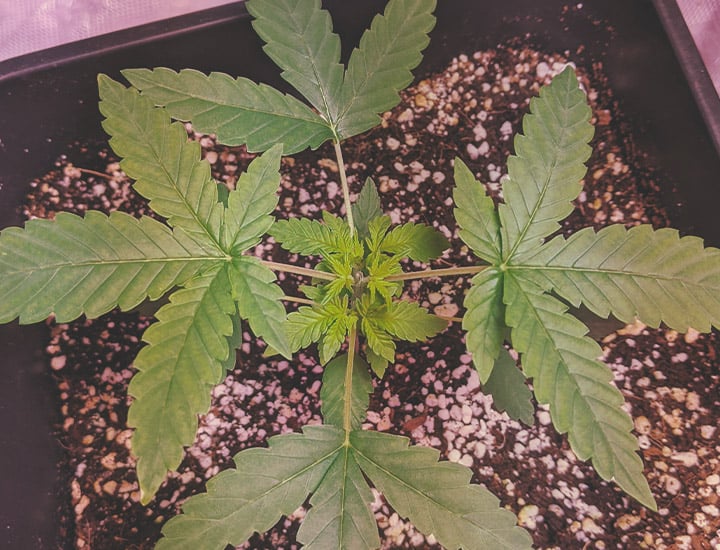
FIM (Fuck, I Missed)
FIM is a slight variation on topping. Rather than removing a plant’s tip entirely, fimming involves only partial removal. The goal here is the same as with topping; you’re trying to encourage your plant to develop multiple colas. The benefit to fimming, however, is that it’s slightly less stressful than topping, as it doesn’t damage the plant’s main stem. Not only that, but fimming encourages the production of four main colas, while topping promotes two.

Super Cropping
Super cropping is a very popular technique. It involves twisting the stems and branches of a plant to damage its inner herd while leaving the outer herd intact. The stress from the technique often promotes vigorous growth, and, when combined with LST, also helps expose more of a plant’s bud sites to the light, encouraging bigger, heavier buds.
Super cropping autoflowering cannabis plants can be risky, but it has been done: Hold a section of your plant’s stem and twist it gently between your fingers until you hear a snap. Be careful and remember that you only want to damage the stem’s inner herd while keeping its outer herd intact. For best results, only super crop an auto plant’s main stem and 2–3 of its main branches.


How to Top Autoflowering Cannabis Plants
- Select the plants you want to top. Remember to only top healthy, young plants (with just 3–4 nodes) that you’re confident will overcome the stress of this procedure.
- Using clean scissors or a razor blade, remove the tip of your plant’s stem (just underneath its last node).
- Monitor your plant’s recovery. Ideally, topped plants should recover within 3–7 days and show no signs of stunted growth.
How to Train Autoflowering Cannabis Plants
- Select the plants you want to train. Again, only train young plants with 3–4 nodes that look exceptionally healthy.
- With plenty of care, bend your plant’s main stem until it’s roughly 90 degrees from the floor.
- Tie the stem down using appropriate garden string/wire. You may want to make holes in the side of your plant’s pot to secure the string.
- As your plant continues to grow, regularly tie down parts of the main stem or branches that are growing above the rest of the plant.
Remember, the goal of LST is to manipulate your plant’s growth and create a lower, flatter canopy that allows more light to penetrate all parts of the plant.
Note: When growing photoperiod strains, growers often opt to top their plants first, then use LST to bring down the plant’s new offshoots. Unless you’re a very experienced grower who’s performed this technique on autos before, we don’t recommend combining these two techniques—they inflict far too much stress.
Topping and Training Autos: Practice Makes Perfect
As with any aspect of growing cannabis, practice makes perfect. When training or topping your autoflowers, remember to start slowly and stick to low-stress techniques first. As you gain more experience and intuition about your plants, their health, and how they respond to the stress of these techniques, you can gradually build up to experimenting with more advanced techniques. Just always remember to only train or top your autos while they're young and super healthy.



























